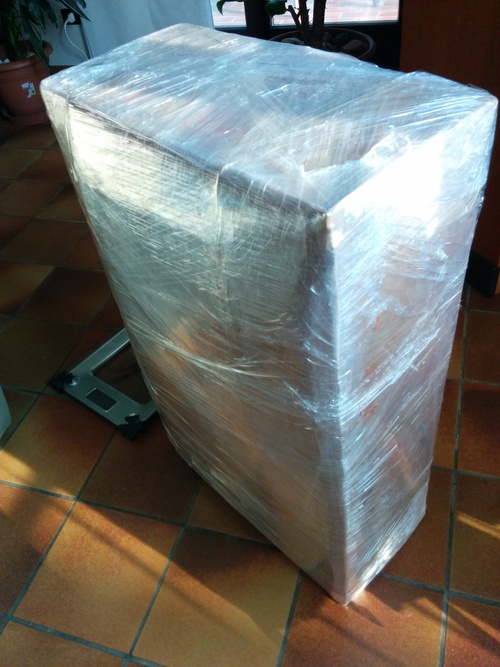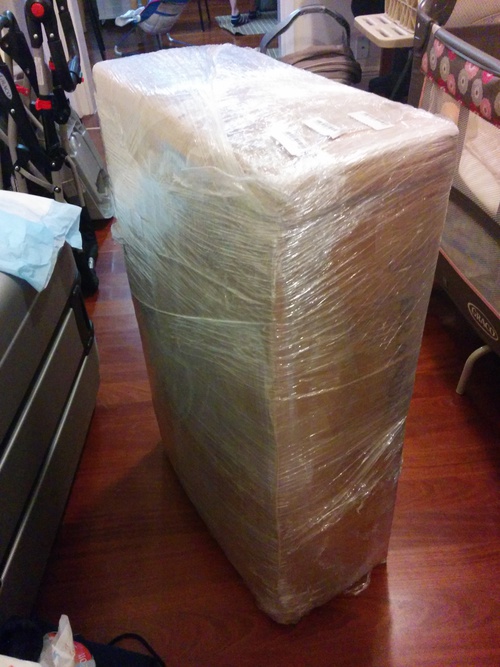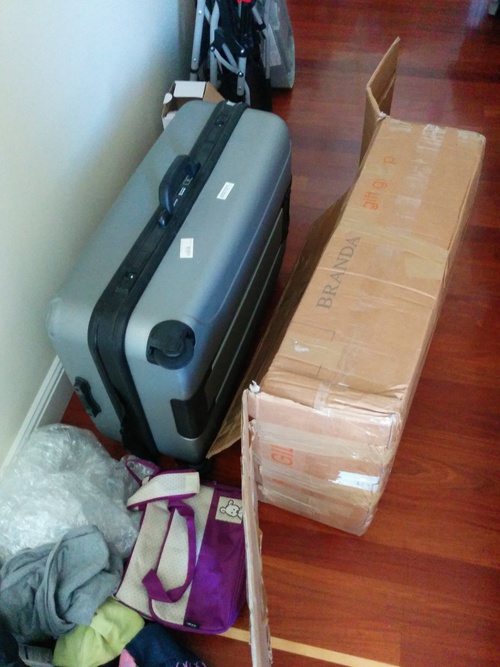When cardboard boxes are better than suitcases
Have you ever had to pay extra fees to carry oversize luggage? Flown somewhere, ended up buying so many things that they did not fit your suitcase anymore?
Here's a nifty trick we used in our last trip to Europe which allowed us to carry much more than we believed we could at no extra charge.
The Basics
First: make sure to read the allowances for carry on and check in baggage on your ticket. Make sure you understand them fully, and if unsure, call your airline.
In our case, me, my wife, and baby were traveling on a Swiss Airlines fligth, and our ticket allowed us to bring for free:
- 2 Carry on bags.
- 3 Checked in bags.
The checked in bags were limited in weight and length:
- 23 Kg (~50 lbs) at most.
- 158 cm (~62 inches) of linear length, where linear length is the sum of the width, depth, and height of your suitcase.
In our case, we discovered that:
-
The large suitcases we used weighted about ~7 Kg (~15 lbs) empty. With no clothes, no items whatsover, the suitcase itself used up ~30% of our allowance!!
-
The small suitcases weighted ~5 Kg empty, or about ~21% of our allowance.
-
None of the suitcases we had was even close to the 158 cm linear length limit. Additionally, we discovered that at least one of the large items we wanted to carry was well within those limits had the suitcase been a little taller and a little thinner.
The solution
Thanks to my long experience as a Tetris player, we soon realized that everything could fit within our free allowance had we had a much lighter and better shaped suitcase.
Easier said than done, though: finding just the right suitcase in terms of size in a super-light yet sturdy material, without any space used up for pockets or the internal mechanisms for wheels at a reasonable price is not an easy task.
But the solution was simple: use a cardboard box. Before you scream bloody murder, consider that a cardboard box does have some really nice properties:
-
It is much lighter - the box we used ended up weighting, empty, just 1.7 Kg, 7.4% of our allowance, or a 22% gain.
-
You can shape it to your will - with scissors, tape and about 30 minutes work you can get pretty much any shape you like, and with no cumbersome weird spaces to fill to allow for wheels and handles.
-
It is dirt cheap - you can buy a cardboard box big enough for about ~5 USD anywhere in the world, and probably get one for free at any supermarket or store if you ask nicely.
-
It is so cheap you don't care if it breaks - as long as your stuff is safely held together inside.
-
It is solid - especially if you wrap it in plastic before checking it in.
-
It can be carried by any airline - I looked online for a while, and could not find any airline that would refuse to carry a cardboard box, as long as it fit the required dimensions. And by experience, I can tell you I have not had any problem so far.
It does have a few drawbacks though:
-
It does not have wheels or handles, which makes it harder to carry, especially if you need to use public transports. Moving within airports is fine though, as you can easily get carts.
-
Water and humidity may cause it to fall apart more easily. But don't fear: if you bag your clothes and don't skimp on packaging tape, even if the cardboard breaks your beloved ownings will be well protected. For additional protection (and insurance!) you can even plastic wrap the cardboard box at the airport.
The process
The first thing I did was figure out what the best box for my purpose would be. Given that I had to carry an item that was about 80 cm long, I decided that my ideal "suitcase" would be about 81 cm x 54 cm x 22 cm, or 157 cm or total linear length (with the limit being 158 cm). In inches: 31 3/4 x 21 1/4 x 8 3/4.
So, what I did was simple:
-
While in a random shop, I asked if I could take a random cardboard box I saw lying around. The important bit is that the box length + width is greater than the length + width you need, and well, that it is taller than you need it to be.
-
I opened the box on the top and bottom sides carefully, and cut through one of the corners, along the corner, to get a nice flat cardboard surface to work on. One of the corners is usually glued, if you prefer instead you can easily pull the two sides apart.
Now I worked to get back a box of the right size:
-
Starting from one side of the cardboard box, and along the length, I folded at the desired width. Than again at the desired length, desired width, and desired length. The trick here is to keep the sides about 1 cm (1/2 inch) shorter, so the outer size of the box is the desired one, rather than too large due to measurment errors and/or the thickness of the material. You can use a piece of wood or a wood corner in the furniture of the room to make nice sharp and straight folds.
-
At the end, I cut the leftover material, and used duct tape to get back a parallelepiped.
-
Now I cut through the corner of the upper and lower side, so I could fold again the bottom and top. Make sure the cut is long enough so that the side of the box ends up of the right height.
-
Again, use the tap to seal the bottom.
-
Fill the box, bagging the content if you are worried about liquids / humidity, seal the top, and profit!
Really: the process will take at most 30 mins, it is much simpler done than explained, and if you are careful with your measurements, you'll get a box just of the right size.
The result
So, this is what I ended up checking in:

Swiss took it withoug blinking an eye. This is how it arrived:

Nice and clean, without issues. And here is what it looks like once opened in comparison with my largest suitcase:

Note how my expensive suitcase is somehow slightly wider and shorter, and due to this, would have not fit the object I wanted to carry with me. Note also that the box is much more spacious on the inside: the thickness of the cardboard uses less space, the corners are straight rather than rounded, and no space is used by the mechanisms for the wheels, pockets, zippers and so on.
The economics
If I look on a random web site for suitcases, like amazon or ebags.com and go for the "extra large" "checked in" size, there are a few things you can notice:
-
Some of the suitcases being sold would not meet the free check in airline requirements. Linear length is often > 62 inches, or 158 cm. Sometimes even by a few inches (65, 66, ...). Doubtful they will come after you, but they may charge you extra.
-
Most of the suitcases weight around 6 to 7 kg, and if you look at the picture inside, you can clearly see that much of the space is taken by zippers, wheels, ... Corners are almost always rounded.
-
The price goes anywhere from ~90 $ to ~1500 $ for the "extra large size". Even assuming we had to pay 10 $ for a cardboard box (bagging, wrapping, cart rental, ...), if you bought cardboard boxes instead of suitcases you'd be saving for 9 to 150 trips. And note that some of the cheaper suitcases are not that sturdy and may not even last that long.
Conclusions
Using cardboard boxes instead of suitcases sounds certainly very attractive to me at this point :)
This also helps saving space in my little house when not traveling (no need for a suitcase hanging around), and relieves the stress of having to choose / replace / fix the suitcase when broken. I can also dispose of a smaller box easily in exchange for a larger one (or the other way around) when travling, while I would certainly feel bad about leaving around or changing suitcases.
The only open question is how to get wheels: a handle is easy to build with duct tape, but wheels are certainly useful when the trip involves a fair amount of public transports.
Other posts
- Replacing and resizing a linux software raid, live Let me describe the scenario: You have a linux software raid (raid5, in my case, created with mdadm). On top of it, you have a few LVM volumes, and...
- Speeding up the Carbon X1 Trackpad Let's say you have a Carbon X1 5th gen . Let's say your trackpoint is an TPPS/2 Elan TrackPoint (and you can check this by running xinput |grep -i Tr...
- Using docker for persistent development environments When thiking about Docker and what it is designed to do, what comes to mind are disposable containers : containers that are instantiated as many times...
- Docker networking on Linux When you run a an application under docker, you have a few different mechanisms you can choose from to provide networking connectivity. This article ...
- Resizing an encrypted filesystem with LVM on Linux I recently had to increase the size of an encrypted partition on my Debian server. I have been a long time user of LVM and dm-crypt and tried similar ...